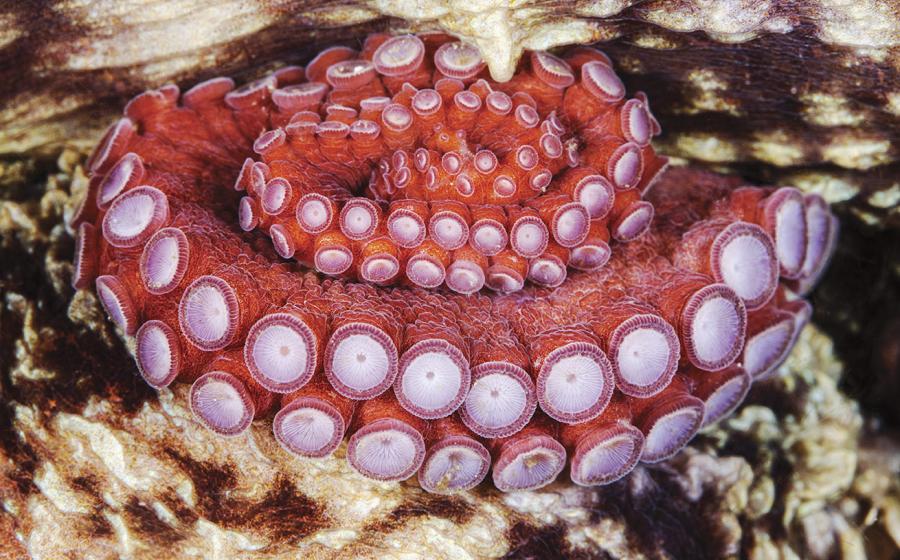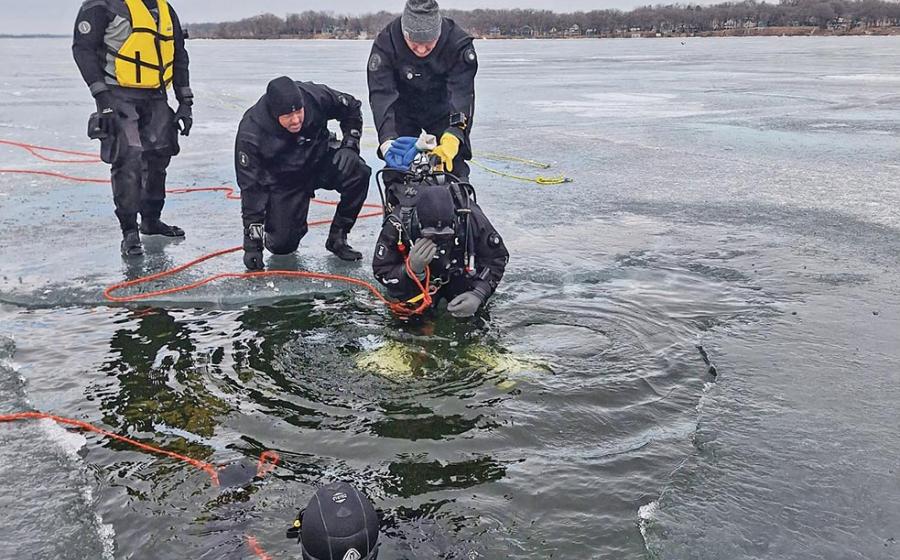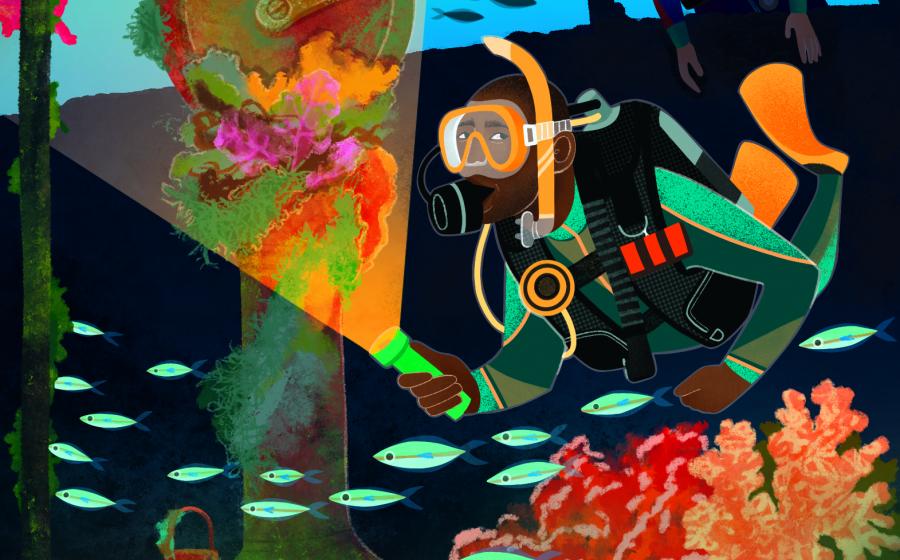Baja Grows Up
At first, there was nothing but green murk. We could see dozens of sea lions on nearby rocks but none in the water. We paddled around, growing colder by the second in the 65-degree surf. Then a bullet shape streaked toward us, twisting, folding and spiraling, all these moves occurring at once. It was a young male sea lion playing his one-sided game of chicken. He turned upside down and came right at our faces, veering off just at the last second.The Los Islotes sea lion colony in the Sea of Cortez off La Paz, Mexico, numbers 300 or so these days. After 15 years of diver visits, the animals are rather used to people in the water.Los Islotes, themselves, have become a diving landmark. They're two chunks of crumbling red rock, frosted with white guano and literally covered with sea lions that live here year-round and have babies in midsummer. By the time we arrived in January, the pups were half the size of the 8-foot-long adults. They were insatiably curious and more than willing to play with anything that swam their way.We were camping on a nearby beach, and so it was easy for us to go back the next day for a second visit. A couple of us swam to an arch in the rock and soon discovered why it is one of La Paz's most popular dive sites. Rising 40 feet above us and sinking another 40 feet below, its sides were covered with cup sponges and purple gorgonians.A school of anchovies surrounded us, thousands of small silver fish in a synchronized line of crinkling tinsel that parted as we approached, bending around our bodies but staying within arm's reach. The fish life was really thick - sergeant majors, damselfish, angels - hundreds of fish packed so tightly you could hardly see past them.The fascinating thing about all this is that we were snorkeling. We could only imagine what we might have seen had we had scuba gear and arrived during the summer dive season.I could remember vividly my trip here in 1980 and couldn't help thinking that this sea lion encounter and many others wouldn't have been possible a couple of decades ago.Twenty years ago, a friend took me to the Baja coast in search of a particularly picturesque shipwreck. We drove into the desert, down dusty roads, before finally cutting off-road across rock and cactus. Eventually, we reached the ocean and found the wreck. When I returned this year, I wanted to revisit the site.''Any idea how I might find the old shipwreck?'' I asked at the front desk, thinking about Jeep rentals and a hearty cross-desert trek. ''Oh, go about 100 yards down the beach, just off the golf course,'' came the reply. Indeed, it was a five-minute walk and barely 50 yards off the manicured grass. The ''outback'' is quite a bit farther out these days in Cabo. But if that is a minus, there are several surprising pluses:- a more efficient, regulated dive-shop network;- a healthy, rapidly growing population of whales;- amazing varieties of marine animal encounter opportunities;- and, for better or worse, more hotels, restaurants, shops and tour companies than any mere mortal could hope to choose from.There were perhaps a handful of dive operators in all of Baja 20 years ago. Today, the Lonely Planet's Diving and Snorkeling Baja California guide lists 13 shops in Cabo alone, another 20 spread across the rest of Baja and five live-aboards.When I arrived at Amigos del Mar, a PADI-affiliated shop in Cabo, the first thing manager Kevin Colter did was to ask for our certification cards. He then proudly showed off his boat, a 36-foot trimaran outfitted with toilets, a freshwater hose and enough lifejackets for everyone aboard. Don't laugh. These amenities were not standard in the past.PELAGIC PLACE: Colter took our group, which included a couple of novices, to his local check-out dive site called Neptune's Finger. It was loaded with Cortez stingrays and morays. On our way back to the dock, we wound up in the middle of a school of dolphins while two sea lions hovered nearby and a whale spouted hardly 100 yards away. It's this pelagic life that makes Cabo special.Last February, Colter was out with a group of divers not far from where we were diving when a 40-foot whale shark joined the group. ''I put out my hand to just run it down his side, and I could feel his beating heart right up my arm to my shoulder,'' he recalls.The gray whales migrate more than 10,000 miles every year, rotating between the North Pacific in the Bering Sea and calving lagoons in Baja. Whalers had hunted the population down to 4,000 in the 1940s, but protective regulations have helped increase the population to about 23,000.Today, several companies offer trips to see and often touch whales. Mostly, this is done in two bays - San Ignacio and Magdalena - both halfway up Baja on the Pacific side. People go out in open skiffs called pangas, and, if they are lucky, young whales come right up to the boat. They get to photograph and sometimes touch whales. Some folks even kiss whales.CABO TODAY: Before a road was built down the 800-mile-long peninsula in 1973, the only way into Cabo was by private boat or airplane. There were a handful of exclusive hotels catering to the likes of Bing Crosby and Lucille Ball. By 1980, there was also a scattering of small motels. But the big push started when the Mexican government decided to reinvent Cabo as a golf destination in the '90s.Today, the beach between the towns of Cabo San Lucas and San Jose del Cabo is lined with hotels and condos, earning it the name ''Los Cabos Corridor.'' The area's population has grown tenfold since 1980 to 100,000, and the town of Cabo has a strange, non-exotic feel. There is Pizza Hut, Burger King, Dairy Queen and a Hard Rock Cafe. But this is still Mexico. There's also the Giggling Marlin, where they'll gladly hang you upside down and pour tequila down your throat.The upside of this growth is that you won't lack for much when you're here. The downside, environmentalist Enrique Hambleton pointed out, is that every two acres of golf course uses as much water as a village of 3,000 people. Yes, the hotels and golf courses have desalination plants, but the extra employees needed to staff them do not. I thought hard about this issue. But frankly, I also recalled my sea lion encounter, which would not be possible without some of this development.Back in the water at the end of my second trip to Los Islotes, I managed to attract my very own sea lion. He circled my body, running a series of tight spirals, then leapt from the water and did backflips in the air. I tried to follow, twisting and diving until I was exhausted and dizzy.Finally, my new pal started the chicken game again, skimming in upside down so I could see his creamy beige chin and one huge, brown eye. He darted in closer and actually bumped my cheek, grazing my nose with his whiskers. Then he was gone. GETTING THERE:Dive season in southern Baja California is from July through mid-December. The water averages 80 degrees with 60- to 80-foot visibility. Water temperatures in mid-winter can hit the low 60s with half the summer visibility. A typical two-tank dive runs about $60 plus $20 for gear rental. The kayaking season is spring and fall, with 10-day trips running $1,200.Five airlines bring more than a dozen flights to Cabo daily from gateways that include Los Angeles, Phoenix, Seattle, Arizona, Dallas and Houston, plus new service from Chicago.Los Cabos Tourism Bureau800-847-4822Web site: www.visitcabo.comAmigos del Mar Diving800-344-3349Web site: www.amigosdelmar.comE-mail: [email protected]. Solmar V Live-Aboard800-344-3349310-459-9861Web Site: www.solmar.comE-Mail: [email protected] Sea and Adventures Inc. Kayaking & Snorkeling800-355-7140Web site: www.kayakbaja.comE-mail: [email protected]










